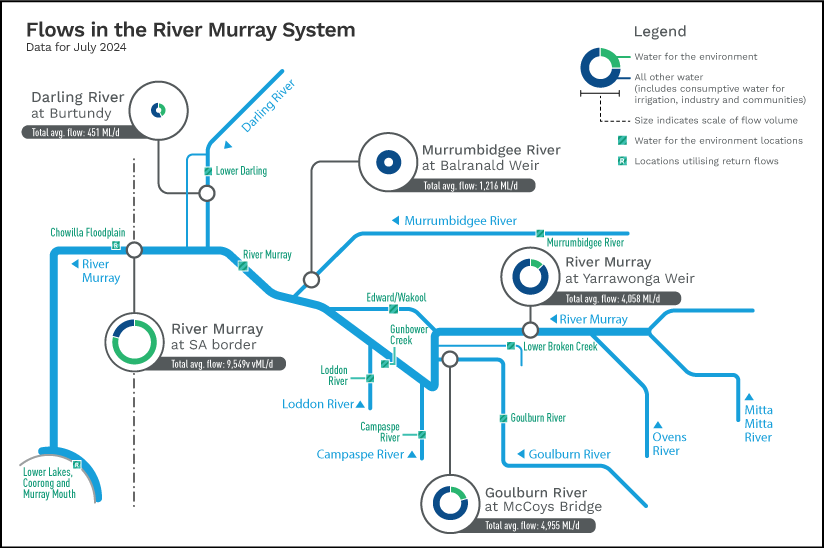Flows in the River Murray System vary widely depending on a range of factors, including rainfall, inflows, evaporation, and demands for water from all users.
At any given time, water flowing through the river is destined for various uses, including irrigation, industry, communities, the environment, and meeting South Australia’s flow entitlement.
The exact mix of these flow components is determined by a number of factors including demand and water availability.
Each month we provide an update showing flows in the River Murray System including the total volume of water flowing for consumptive use and to care for the environment. The update also outlines the intended environmental outcomes.

River flow information
The July flow to South Australia included water for South Australia’s entitlement, traded volumes and water for the environment. Water for the environment at the South Australian border throughout winter-spring comes primarily from return flows from upstream environmental water use.
During June, environmental water released from Menindee Lakes moved poor quality water from the Lower Darling/Baaka River, into the River Murray and towards South Australia. To mitigate poor water quality impacts on South Australia, a portion of environmental water was diverted into Lake Victoria/Tar-ru and has been released into the Murray throughout July, as higher flows from upstream in River Murray reach the South Australian border and add further dilution to the poor quality water captured in June.
For the latest information on water for the environment see the River Murray weekly report.
Intended environmental outcomes
Water for the environment takes time to move through the system. Water from past watering events is still moving through the River Murray as return flows. Environmental water holders can also use water for the environment by extracting allocations directly from the river. These allocations are often used for small-scale watering events rather than having water delivered from a storage.
| Location | Return flows used at site | Intended environmental outcomes |
|---|---|---|
| River Murray |
|
|
| Edward/Kolety-Wakool River system | Yes |
|
| Gunbower Creek | No |
|
| Lower Broken Creek | N/A |
|
| Goulburn River | N/A |
|
| Campaspe River | N/A |
|
| Loddon River | N/A |
|
| Lower Baaka (Darling) River | No |
|
| Lower Lakes, Coorong and Murray Mouth | Yes |
|